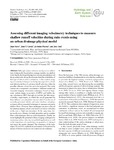Mostrar o rexistro simple do ítem
Assessing Different Imaging Velocimetry Techniques to Measure Shallow Runoff Velocities During Rain Events Using an Urban Drainage Physical Model
| dc.contributor.author | Naves, Juan | |
| dc.contributor.author | García Bermejo, Juan Tomás | |
| dc.contributor.author | Puertas, Jerónimo | |
| dc.contributor.author | Anta, Jose | |
| dc.date.accessioned | 2021-04-13T15:33:22Z | |
| dc.date.available | 2021-04-13T15:33:22Z | |
| dc.date.issued | 2021 | |
| dc.identifier.citation | Naves, J., García, J. T., Puertas, J., and Anta, J.: Assessing different imaging velocimetry techniques to measure shallow runoff velocities during rain events using an urban drainage physical model, Hydrol. Earth Syst. Sci., 25, 885–900, https://doi.org/10.5194/hess-25-885-2021, 2021. | es_ES |
| dc.identifier.uri | http://hdl.handle.net/2183/27739 | |
| dc.description.abstract | [Abstract] Although surface velocities are key in the calibration of physically based urban drainage models, the shallow water depths developed during non-extreme precipitation and the potential risks during flood events limit the availability of this type of data in urban catchments. In this context, imaging velocimetry techniques are being investigated as suitable non-intrusive methods to estimate runoff velocities, when the possible influence of rain has yet to be analyzed. This study carried out a comparative assessment of different seeded and unseeded imaging velocimetry techniques based on large-scale particle image velocimetry (LSPIV) and bubble image velocimetry (BIV) through six realistic but laboratory-controlled experiments, in which the runoff generated by three different rain intensities was recorded. First, the use of naturally generated bubbles and water shadows and glares as tracers allows unseeded techniques to measure extremely shallow flows. However, these techniques are more affected by raindrop impacts, which even lead to erroneous velocities in the case of high rain intensities. At the same time, better results were obtained for high intensities and in complex flows with techniques that use artificial particles. Finally, the study highlights the potential of these imaging techniques for measuring surface velocities in real field applications as well as the importance of considering rain properties to interpret and assess the results obtained. The robustness of the techniques for real-life applications yet remains to be proven by means of further studies in non-controlled environments. | es_ES |
| dc.description.sponsorship | The project receives funding from the Spanish Ministry of Science and Innovation under POREDRAIN project RTI2018-094217-B-C33 (MINECO/FEDER-EU) | |
| dc.description.uri | https://doi.org/10.5194/hess-25-885-2021-supplement | |
| dc.language.iso | eng | es_ES |
| dc.publisher | Copernicus GmbH | es_ES |
| dc.relation | info:eu-repo/grantAgreement/AEI/Plan Estatal de Investigación Científica y Técnica y de Innovación 2017-2020/RTI2018-094217-B-C33/ES/CARACTERIZACION DE LA ELIMINACION DE CONTAMINANTES Y EVALUACION LA EFICIENCIA DE SECCIONES FILTRANTES PARA LA GESTION SOSTENIBLE DE SISTEMAS URBANOS DE DRENAJE A ESCALA CIUDAD | |
| dc.relation.uri | https://doi.org/10.5194/hess-25-885-2021 | es_ES |
| dc.rights | Atribución 4.0 Internacional | es_ES |
| dc.rights.uri | http://creativecommons.org/licenses/by/4.0/ | * |
| dc.subject | Surface water velocities | es_ES |
| dc.subject | Physically based urban drainage models | es_ES |
| dc.subject | Shallow depths | es_ES |
| dc.subject | Floods | es_ES |
| dc.subject | Velocimetry techniques | es_ES |
| dc.subject | Water runoff | es_ES |
| dc.title | Assessing Different Imaging Velocimetry Techniques to Measure Shallow Runoff Velocities During Rain Events Using an Urban Drainage Physical Model | es_ES |
| dc.type | info:eu-repo/semantics/article | es_ES |
| dc.rights.access | info:eu-repo/semantics/openAccess | es_ES |
| UDC.journalTitle | Hydrology and Earth System Sciences | es_ES |
| UDC.volume | 25 | es_ES |
| UDC.issue | 2 | es_ES |
| UDC.startPage | 885 | es_ES |
| UDC.endPage | 900 | es_ES |
| dc.identifier.doi | 10.5194/hess-25-885-2021 |






